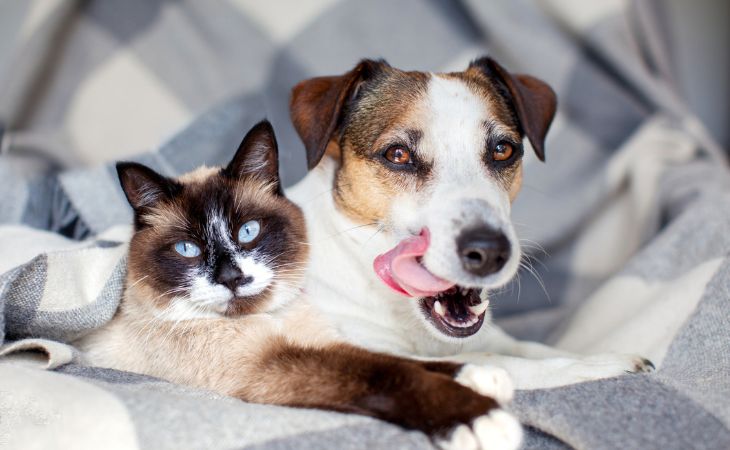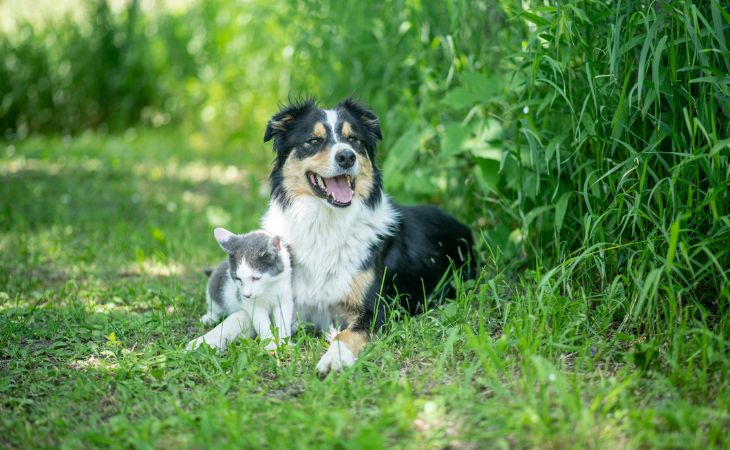Successful cohabitation between a dog and adult cat means living peacefully together and being able to establish a friendly relationship. However, getting to this point can be a challenge because these two animals have instincts and behaviors that are different. The harmony that you are looking for is not created by magic. Rather, it is through meticulously orchestrated steps. From the initial preparation of your pets’ environment to the evolution towards a peaceful coexistence, every decision, interaction, and shared moment is an essential building block to your pets’ unique relationship.
Prepare an environment for your cat’s and dog’s cohabitation
Before starting cohabitation between a dog and adult cat, you need to put in place some key elements to facilitate this complex transition. A well-prepared environment will ensure gentle adaptation. Make sure to set up specific zones for each of them.
Cats love to be high up. Because of this, set up high areas by placing hammocks, cat trees, and shelves where your cat can go to if needed. By offering your cat areas that are high up, you are guaranteeing their feeling of safety. When it comes to dogs, they appreciate more comfortable areas with soft cushions where they can rest.
To avoid any potential conflict related to food or toilet time, provide each animal with their own distinct resources. Provide litter boxes, water bowls, and separated food in different zones of the house. This separation prevents potential rivalries and gives each animal a space in which they can feel safe to eat and relieve themselves.
You can also use soothing pheromone diffusers at home. This will help to calm you cat during their first few interactions with your dog. Pheromones mimic the chemical signals cats naturally release to feel secure. By diffusing them in your home, you’ll create a more serene atmosphere that will promote a smoother transition.
To facilitate cohabitation and adaptation, exchange their objects (pillows, toys, etc.). The objective here is to allow them to progressively get used to the smell of each other. This will, therefore, reduce the initial shock when they see each other face to face.
Make controlled encounters and gentle first contacts
Once you have carefully prepared the environment, it is time to pass to the first encounters between your dog and cat. To ensure safety and minimize the initial stress, you can opt for a first encounter through a barrier. This can be through a door, a fence, or a fishnet. This barrier will allow for visual and olfactive interaction without the risk of confrontation. This will give each animal an opportunity to get used to the presence of the other without feeling threatened.
You can also use a leash to keep your dog under control. Then, let your cat approach at their own pace and let them see each other from a secure distance. Reward the calm and positive behaviors of both pets with treats and caresses. This will reinforce their positive association with the presence of the other.
Limit the interactions to short sessions of a few minutes each time. Watch your dog’s and cat’s reactions carefully. If you notice that stress seems to be increasing, put an end to the encounter.
The first steps of introduction form the basis for other future harmonious encounters between your dog and cat. Patience and positivity are essential to this delicate phase of cohabitation. This is what will allow each of your pets to get used to each progressively and trust in each other’s presence.
You might find this article interesting: Understanding your cat’s emotions

Set up free interactions and use positive reinforcement
Now that you have successfully followed the first introductory steps, it is time to progress towards freer interactions. With that being said, it is important to maintain constant vigilance. This supervision is essential for a harmonious and balanced cohabitation between your precious companions.
If the first encounters on a leash or through a barrier went well, you can plan to allow your cat to move around freely in the room in the presence of your dog. During this time, you can still keep your dog on a leash. This approach allows your cat to feel safe and gives your dog the opportunity to get used to the presence of your cat without tension. Every moment your dog shows good behavior, such as ignoring your cat, having friendly curiosity, or acting calm, deserves instant rewards.
You can gradually increase the duration of these sessions. When doing this, keep an eye on their reactions and body language. If your cat seems stressed or feels overwhelmed, respect their needs and let them get away to where they feel safe. Keep in mind that frequent breaks can help to prevent this overwhelming feeling.
Use these interactions to incorporate obedience sessions with your dog. Teach them commands like “sit” and “come”. If they succeed in following the command, reward this behavior. This can not only reinforce the control of your dog, but also stimulate their concentration, which can contribute to discouraging their undesired behavior.
How can cats and dogs live together harmoniously on a daily basis?
After going through all the steps of preparation and taking the adequate precautions, cohabitation needs to become a daily reality.
Put in place a daily routine
It is necessary to establish regular routines for your pet’s meals, outings, and playtime. Dogs and cats are animals of habit that feel reassured when it comes to the predictability of their day. This stability contributes to their well-being and reinforces their feeling of safety.
Always keep an eye on them to prevent conflicts
Be on the lookout for subtle signs of tension or stress between your dog and cat. If a conflict breaks out, intervene calmly to separate them without punishment. Early intervention can prevent conflict situations from escalating and becoming long-lasting.
Encourage playful interaction
Playtime between dogs and cats is invaluable for strengthening their bond and exercising. However, you should always monitor these interactions to prevent their this activity from getting too intense. We recommend using interactive toys that stimulate their shared interest and help them channel their energy in a positive way.
Respect the personality of each animal
Each of your furry friends have their own personality and needs. For example, your dog may be more interested in playing and exploring. While your cat, on the other hand, may prefer moments of peace and quiet. It’s important to take these differences into account, and allow each animal the opportunity to retreat to their own personal space when necessary.
Take advantage of positive moments
It’s great to celebrate positive steps that your pets have made regarding their cohabitation. If you catch them playing together, napping close to each other or sharing relaxing moments, reward them with treats and praise. This positive approval will reinforce this behavior and encourage their bond to grow as times passes.
Make time for each animal
To avoid creating a rivalry between your pets or having your pets feel neglected, it’s important to dedicate time to each of them individually. You can reinforce their bond with you by petting them, giving them attention, and playing with them alone. This will also allow you to boost their mood. In addition, these special moments make it possible to create balance and ensure that each of your pets feels loved.
You might find this article useful: My cat is aggressive towards my dog

